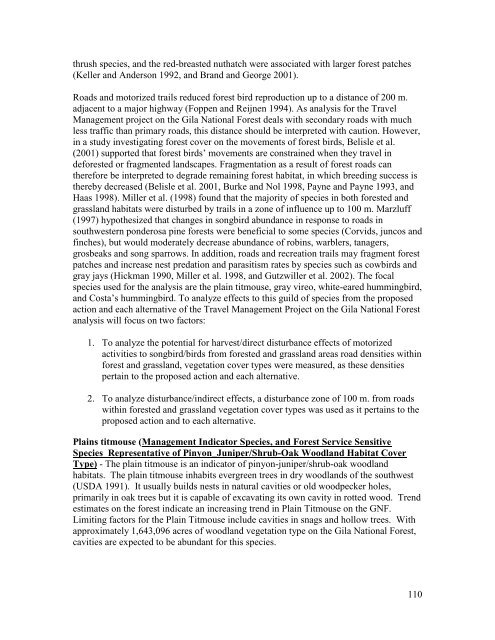Wildlife Specialist report
Wildlife Specialist report
Wildlife Specialist report
Create successful ePaper yourself
Turn your PDF publications into a flip-book with our unique Google optimized e-Paper software.
thrush species, and the red-breasted nuthatch were associated with larger forest patches<br />
(Keller and Anderson 1992, and Brand and George 2001).<br />
Roads and motorized trails reduced forest bird reproduction up to a distance of 200 m.<br />
adjacent to a major highway (Foppen and Reijnen 1994). As analysis for the Travel<br />
Management project on the Gila National Forest deals with secondary roads with much<br />
less traffic than primary roads, this distance should be interpreted with caution. However,<br />
in a study investigating forest cover on the movements of forest birds, Belisle et al.<br />
(2001) supported that forest birds’ movements are constrained when they travel in<br />
deforested or fragmented landscapes. Fragmentation as a result of forest roads can<br />
therefore be interpreted to degrade remaining forest habitat, in which breeding success is<br />
thereby decreased (Belisle et al. 2001, Burke and Nol 1998, Payne and Payne 1993, and<br />
Haas 1998). Miller et al. (1998) found that the majority of species in both forested and<br />
grassland habitats were disturbed by trails in a zone of influence up to 100 m. Marzluff<br />
(1997) hypothesized that changes in songbird abundance in response to roads in<br />
southwestern ponderosa pine forests were beneficial to some species (Corvids, juncos and<br />
finches), but would moderately decrease abundance of robins, warblers, tanagers,<br />
grosbeaks and song sparrows. In addition, roads and recreation trails may fragment forest<br />
patches and increase nest predation and parasitism rates by species such as cowbirds and<br />
gray jays (Hickman 1990, Miller et al. 1998, and Gutzwiller et al. 2002). The focal<br />
species used for the analysis are the plain titmouse, gray vireo, white-eared hummingbird,<br />
and Costa’s hummingbird. To analyze effects to this guild of species from the proposed<br />
action and each alternative of the Travel Management Project on the Gila National Forest<br />
analysis will focus on two factors:<br />
1. To analyze the potential for harvest/direct disturbance effects of motorized<br />
activities to songbird/birds from forested and grassland areas road densities within<br />
forest and grassland, vegetation cover types were measured, as these densities<br />
pertain to the proposed action and each alternative.<br />
2. To analyze disturbance/indirect effects, a disturbance zone of 100 m. from roads<br />
within forested and grassland vegetation cover types was used as it pertains to the<br />
proposed action and to each alternative.<br />
Plains titmouse (Management Indicator Species, and Forest Service Sensitive<br />
Species Representative of Pinyon_Juniper/Shrub-Oak Woodland Habitat Cover<br />
Type) - The plain titmouse is an indicator of pinyon-juniper/shrub-oak woodland<br />
habitats. The plain titmouse inhabits evergreen trees in dry woodlands of the southwest<br />
(USDA 1991). It usually builds nests in natural cavities or old woodpecker holes,<br />
primarily in oak trees but it is capable of excavating its own cavity in rotted wood. Trend<br />
estimates on the forest indicate an increasing trend in Plain Titmouse on the GNF.<br />
Limiting factors for the Plain Titmouse include cavities in snags and hollow trees. With<br />
approximately 1,643,096 acres of woodland vegetation type on the Gila National Forest,<br />
cavities are expected to be abundant for this species.<br />
110
















